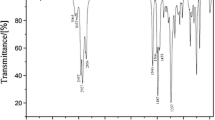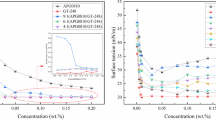Abstract
The surface activities and application properties of didecyldimethylammonium formate (DDAF) and sodium fatty alcohol ether carboxylate (AEC-9Na) mixed systems were measured. The results showed that the critical micelle concentration and surface tension of mixed systems have lower values than that of a single surfactant solution, which is attributed to the synergism of DDAF and AEC-9Na. It was found that the emulsifying properties for kerosene and wetting properties of the mixed systems were also better than single component surfactants. In addition, the mixed systems of AEC-9Na (16 wt%) with DDAF showed both better detergency and excellent antibacterial properties.






Similar content being viewed by others
References
Shiloach A, Blankschtein D (1997) Prediction of critical micelle concentrations and synergism of binary surfactant mixtures containing zwitterionic surfactants. Langmuir 13:3968–3981
Mulqueen M, Blankschtein D (2000) Prediction of equilibrium surface tension and surface adsorption of aqueous surfactant mixtures containing zwitterionic surfactants. Langmuir 16:7640–7654
Christov NC, Denkov ND, Kralchevsky PA, Ananthapadmanabhan KP, Lips A (2004) Synergistic sphere-to-rod micelle transition in mixed solutions of sodium dodecylsulfate and cocoamidopropyl betaine. Langmuir 20:565–571
Bera A, Ojha K, Mandal A (2013) Synergistic effect of mixed surfactant systems on foam behavior and surface tension. J Surfactants Deterg 4:621–630
Upadhyaya A, Acosta EJ, Scamehorn JF, Sabatini DA (2007) Adsorption of anionic–cationic surfactant mixtures on metal oxidesurfaces. J Surfactants Deterg 10:269–277
Sohrabi B, Gharibi H, Tajik B, Javadian S, Hashemianzadeh MJ (2008) Molecular interactions of cationic and anionic surfactants in mixed monolayers and aggregates. J Phys Chem B 112:14869–14876
Cui ZG, Canselier JP (2001) Interfacial and aggregation properties of some anionic/cationic surfactant binary systems II. Mixed micelle formation and surface tension reduction effectiveness. J Colloid Polym Sci 279:259
Wang RT, Li YL, Li Y (2014) Interaction between cationic and anionic surfactants: detergency and foaming properties of mixed systems. J Surfactants Deterg 17:881–888
Yang XQ, Li PX, Han JY, Xu CQ (2000) The physic-chemical properties of alkyl ether carboxylic acids. China J Books Netw 3:19–22
Schmide WW (1997) Alcohol ethoxycarboxylates mild and high foaming surfactants for personal care products. JAOCS 74:1–5
Xia ZS, Chen ZQ (2004) Study on application properties of sodium laury alcohol polyxyethylene ether actate in daily chemical products. Appl Chem Ind 33(3):9–12
Qiao S, Zhang H, Li Q (2010) Detergency performance of sodium fatty alcohol ether carboxylate surfactant series. China Surfactant Deterg Cosmet 40(4):250–255
Zhao GX, Zhu BY (2003) Principles of surfactant action (Chinese). China Light Industry Press, Beijing
Guo XF, Jia LH (2002) Cationic surfactant and its application (Chinese). Chemical Industry Press, Beijing
Yan HC, Li QX, Geng T, Jiang YJ (2012) Properties of the quaternary ammonium salts with novel counterions. J Surfactants Deterg 15:593–599
Wang GY, Du ZP, Zhang W (2009) Synthesis and surface properties of trisiloxane-modified oligo (ethylene oxide). Tenside Surfactants Deterg 46:214–217
Yang Q, Cao DH, Fang B (2009) Synthesis and properties of a novel zwitterionic gemini surfactant. J Chem Eng Chin Uni 23:110–115
Demberelnyamba D, Kim KS, Choi S, Park SY, Lee H, Kim CJ, Yoo ID (2004) Synthesis and antimicrobial properties of imidazolium and pyrrolidinonium salts. Bioorg Med Chem 12:853–857
Abid CZ, Chattopadhyay S, Mazumdar N, Singh H (2010) Synthesis and characterization of quaternary ammonium PEGDA dentritic copolymer networks for water disinfection. J Appl Polym Sci 116:1640–1649
Acknowledgments
We gratefully acknowledge the financial support from National Key Technology Support Program during the 12th five-year Plan Period (2014BAE03B00), Science and Technology Project of Shanxi Province (20130321019-02), Patent Promotion and Implementation Program of Shanxi Province (20151009) and the Graduate Education Innovation Program of Shanxi Province (2015SY72).
Author information
Authors and Affiliations
Corresponding author
About this article
Cite this article
Tang, W., Geng, T., Jiang, Y. et al. Properties of Didecyldimethylammonium Formate and Sodium Fatty Alcohol Ether Carboxylate Mixed Systems. J Surfact Deterg 19, 399–404 (2016). https://doi.org/10.1007/s11743-015-1781-8
Received:
Accepted:
Published:
Issue Date:
DOI: https://doi.org/10.1007/s11743-015-1781-8




